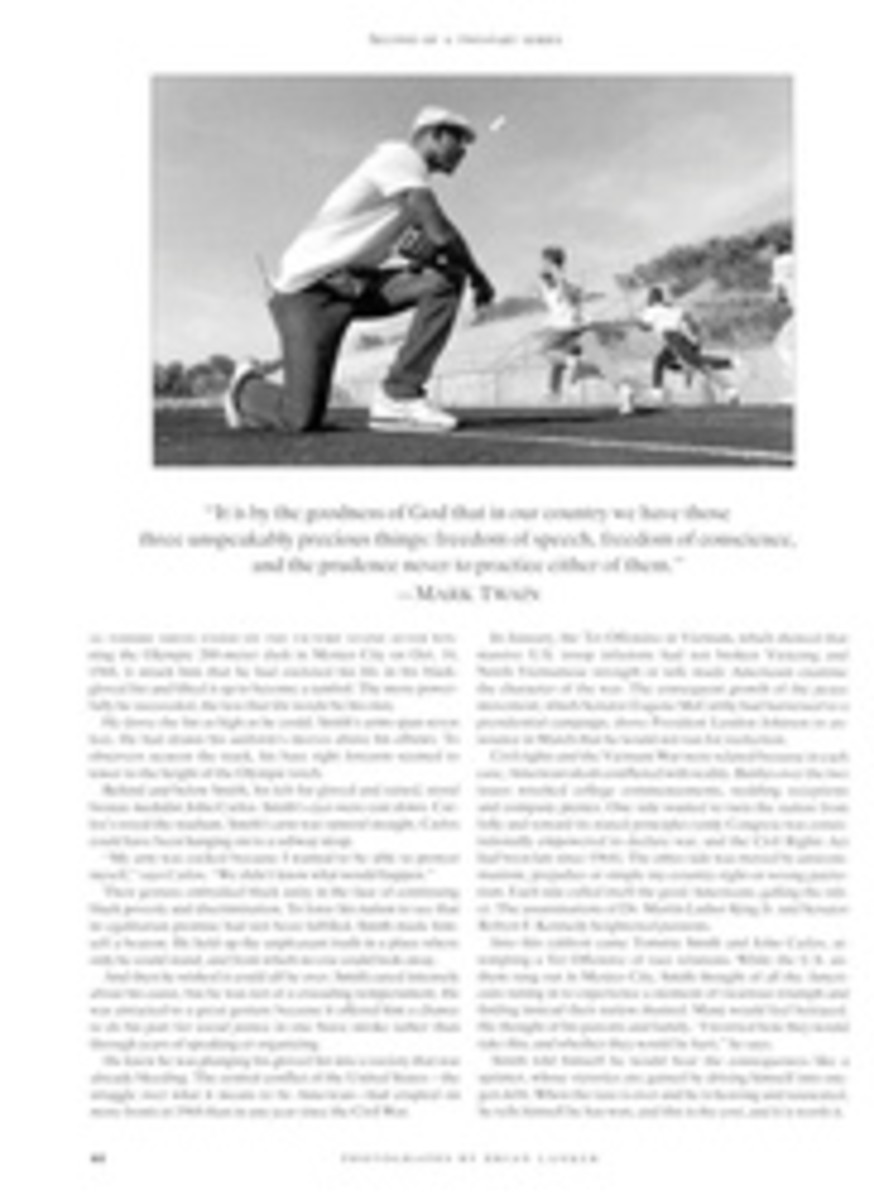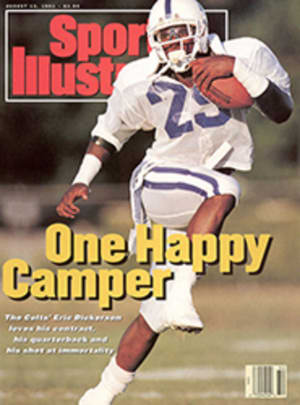
Stroke On, Old Navy Team
The challenge was one that Craig Thrasher, U.S. Naval Academy Class of 1963, couldn't resist: to reunite his old plebe crew to race one more time together. At age 50, Thrasher had only recently rediscovered rowing, after an inspirational viewing of the movie Field of Dreams.
"While the credits were scrolling up," says Thrasher, "I saw myself sitting behind [former crewmate] Hugh [Schall] during a hot spring day, pulling an oar. There was a message for me there. My dream was to row competitively again."
Now, after two years of masters rowing, Thrasher decided to see whether he could persuade his former Navy oarsmen to share his dream.
It wasn't entirely his own idea. In taking up his oar again, Thrasher found himself competing against some of the same rowers he had faced 30 years ago. Last August, Thrasher sat hunched in a four-man shell, awaiting the start of his race at the U.S. Rowing Masters National Championships, near Key Biscayne, Fla., when a voice from a rival crew called out, "Thrasher, you took shirts from me for four years. This time I get yours." The voice belonged to Frank Benson, a former Syracuse oarsman.
It's a crew tradition for the losers to give their shirts to the winners. But Benson and his Orange crew members had plenty of company back in the spring of 1960—nearly every freshman crew in the country was undressed by Thrasher and his Middie mates that season.
The result of that 1990 masters race was much the same for Benson, as Thrasher's four finished a half-length ahead of his shell even though it was beaten for the championship by the Cambridge Boat Club. Benson asked for one more shot: He was putting together a masters regatta of his own, the Capitol Classic, on the Potomac River in Washington, D.C., and wondered if the Middies could reassemble their plebe boat.
Thrasher responded to the challenge. He wrote to his boatmates, figuring he might get four or five guys to commit and then he could fill out the rest of the eight with some younger Navy oarsmen.
"When I got the letter I thought, This is crazy, insane," says seven man Larry Graham. "Then I asked, 'When do I show up?' "
Graham's response was duplicated by the rest of the boat, including coxswain Dick Omohundro and coach Paul Quinn. "As a plebe crew, they were phenomenal," says Quinn, who at 66 is a regional representative for U.S. Rowing. He travels the South from his home in Titusville, Fla., conducting rowing clinics and assisting colleges in getting programs started. "They were the smoothest I ever had."
Also the winningest. In 1960, Thrasher's freshman eight at the Naval Academy went through its regular schedule of regattas undefeated, taking its most prestigious titles at the Eastern Sprints and the Intercollegiate Rowing Association Championships. The Middies' only loss for the season came in the semifinals of the Olympic trials, where they finished one-quarter length behind Navy's varsity, a boat that went on to place fifth at the Olympics that fall in Rome.
They are an eclectic bunch, to be sure. Thrasher, the only one still active in rowing, works for a Buffalo-based consulting firm that specializes in techniques for cleaning up oil spills and hazardous waste. Omohundro is co-president of an investment company in Boston. Stroke Dave Konold, who also was center on the Navy basketball team, lives in San Diego and is the vice-president of a Christian missionary organization. Graham, who blocked as a tackle on the football team for Heisman Trophy winners Joe Bellino and Roger Staubach, became a Navy SEAL and now runs a children's summer camp in Hunt, Texas. Jim Fontana, the six oar, commands the Naval Ocean Systems Center in San Diego. Five man Schall lives outside Seattle and is a partner in an engineering consulting firm. Dick Jones—who as a spare on the crew answered Thrasher's call when the original three seat, John Anderson, injured his hip running—is an aircraft broker. Two man Mike Pero lives in Stamford, Conn., and is in the insurance business, and bow Ted Krohne is a San Diego-based pilot for USAir.
"We're here today because crew is one of those sports that fosters a special relationship among teammates," says Fontana. "Our relationships with each other were much closer than those we had with other people at school."
"Here" is Annapolis, just after dawn on Friday, May 3, 1991. The plebe crew of 1959-60 enters the boathouse for a practice, much as it had 30 years before. Paddling away from the dock, someone light-heartedly yells out, "We have a problem. Ted's hips hang over the side of the boat." The boat is without Jones, who has gone to the Mideast to sell a Boeing 727. He has promised, however, to return in time for the race the following day. His three seat is filled by current Navy plebe coach Martin Stone.
For the first 20 minutes the boat flounders through College Creek. Quinn shuns the electronic speaker system in his launch, choosing instead to bark his commands into an old, hand-held megaphone. They row by fours, then sixes and, finally, together as eight. The boat is sluggish, pitching from side to side as each oar breaks the water in a different cadence from that of the blade in front. Quinn calls for a higher stroke rating, and slowly, the boat begins to level.
Rowing past, cleanly, swiftly, is the current Navy plebe crew. They are in a yellow shell that has CLASS OF '63 painted in gold on both sides of its bow. The boat was donated three years ago by Thrasher and his classmates when they assembled for their 25th reunion. As the Middies of '94 paddle alongside their boat's namesake, they direct a loud cheer of encouragement toward their elders.
"It suddenly hit me what we were doing," says Omohundro. "These plebes sharing our water, rowing next to us, weren't even born when we last raced."
After their workout, the men gather at the boathouse. "There were probably eight strokes where the boat felt really good," says Krohne. "Maybe there will be 12 this afternoon. Maybe tomorrow it'll be 20—who knows, that might be enough."
Fontana shakes his head, stretching out against a carpet-covered bench-press table. "Tomorrow we're going to go out as a shiny, refurbished Model T Ford at a parade," he says. "And somewhere after the first few blocks, maybe a fender will fall off. After a few more blocks, maybe a headlight. But with a little more time, we could make them stay on."
As with most masters regattas—in which rowers must be at least 27 years old—the Capitol Classic uses a handicap system: The average age of each crew is calculated, and then one second is subtracted for every year a crew is older—and presumably slower—than the next one. Navy, with an average age of 50, has a 10-second jump on its competitors from Georgetown and Syracuse. Benson, however, isn't in this boat; his crew has drawn another heat, a fact that isn't lost on Thrasher, who jokes, "He was scared of getting beat again."
With Jones, fresh from his travels, in the boat for the first time, the crew has trouble on the start. Its starboard side lifts, causing several oar blades to miss the water and jerk the boat unevenly. After that, Navy never hits its stride. Most collegiate races are 2,000 meters, but mercifully the Capitol Classic is half that. Georgetown finishes first in 2:54, followed by Syracuse at 2:59 and then Navy, which with its handicap is eight seconds behind the Orangemen. In their prime, the Navy men would have rowed this distance almost half a minute faster.
One major requirement of Benson's regatta is that rowers must attend the party afterward. Navy's oarsmen are glad to oblige. "We had three objectives," says Pero. "One, to have fun; two, to finish the race; and three, to win. So, two out of three ain't bad."
Krohne compares the adrenaline rush he felt during the race with the charge he used to get landing fighter jets on aircraft carriers. And although Thrasher is disappointed by finishing last, he is convinced that they have a future.
"It's going to happen again," he says. "We're talking about getting a boat together for this year's Masters Nationals in Austin, Texas in September."
Omohundro, some 55 pounds heavier than in his Annapolis days, even speaks of a diet regimen. "We found out as much about our future as we did about our past," he says. "In the fall of 1959, we were all the same. No hair, white shoes, scared to death. Now, even though everyone is doing their own thing, we've been brought together again by this sport."
Before returning home, the members of the 1959-60 plebe crew squeeze together against a side boat bay for one last photograph, each man wearing a bright yellow Navy racing jersey and a blue baseball cap. Wide-eyed as a plebe, Krohne turns so he's facing his crewmen, cheeks flushed, and says, "Can you imagine the handicap we'll have at age 60?"
PHOTO
KATHERINE LAMBERT
Thrasher (front, second from left) proved to be an effective recruiter.
PHOTO
GARY CAMERON
Fontana (foreground, right) and his mates couldn't pull off a win.
TWO PHOTOS
JOHN G. ZIMMERMAN
In 1962, Fontana and coxswain Omohundro were featured in an SI article.

